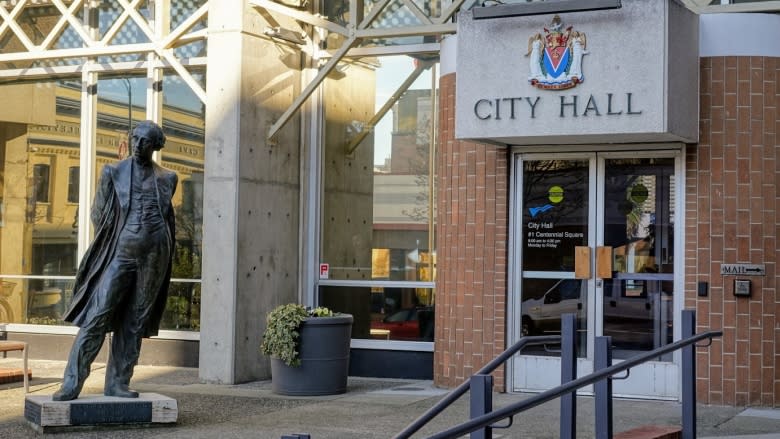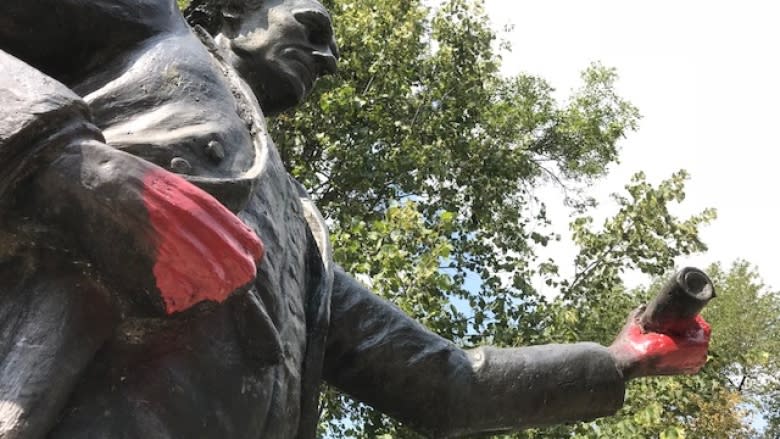Sir John A. Macdonald's legacy to be recast in his native Scotland amid raging debates over historical figures
In Edinburgh, there is no statue of Sir John A. Macdonald, even though, as Canada's first prime minister, he's one of Scotland's most influential exports.
There is, however, a prominent monument to one Henry Dundas, towering above St. Andrew Square in central Edinburgh, the Scottish capital.
In 2016, a young activist super-glued an "alternative" plaque to the monument, recasting Scotland's once-de facto leader as a "great tyrant" for crushing a pro-democracy rebellion, and especially for delaying the abolition of slavery.
After more than two years of heated discussion — and following the removal of several statues elsewhere — Dundas still stands while debate rages on how to reconsider his legacy.
In the middle of it all, Scotland is also considering a recast of Macdonald's legacy.
Controversy from Victoria to Glasgow
Macdonald isn't well known in modern-day Scotland. The Glasgow building most likely to have been his birthplace was levelled this past spring to make way for condos. But he merits mention on the government's website.
A week after the City of Victoria, B.C., removed his statue as part of truth and reconciliation efforts with Indigenous people, the Scottish government eliminated all references to Macdonald from its website — to review his legacy in light of his central role in creating the horrifically abusive residential school system.
For Adam Ramsay, the activist with the super glue, it is a "positive step" that — like the debate over Dundas — means Scotland is moving forward.
"It says Scotland is … beginning to be able to come to terms with some of the stuff that the Scottish ruling elite did," Ramsay, who edits Open Democracy U.K, said in an interview.
Scotland is in a reflective mood. Only in recent years has it managed to debate the role of some of its people in the injustices of the British Empire: among other things, investment in sugar and tobacco plantations abroad that enriched some Scottish people on the backs of slaves.
One of Scotland's foremost historians, Sir Thomas Devine, said the first collection of essays on Scotland and slavery was only published in 2013.
'Historical vandalism'
There is, unsurprisingly, a difference of opinion on whether people should view public relics of controversial past figures through the lens of today's moralities.
To Devine, removing Macdonald's statue (and the articles online) is "historical vandalism."
"These artifacts were created by people in the past who had different, in some cases massively different, values from us," he said in an interview.
Macdonald as prime minister, he said, was "a man of his time," when some of Scotland's universities (as in many other places) were "centres of excellence for racist thought."
For many on both sides of the Atlantic, all that is reason enough to severely downgrade Macdonald in the historical record and uproot him from the present, as the city of Victoria did.
Devine counsels context: a new, carefully written plaque for Dundas and a rewrite of the Macdonald articles online to include "his more negative activities."
A Scottish government spokesman suggested that may be the plan.
An essay on the government's website described Macdonald as a proud "son of Scotland and father of Canada … revered for his key role in the formation of the country as we know it today and is heartwarmingly referred to as the father of Canada."
'Legitimate Indigenous concerns'
In a written statement, the spokesman said they removed the articles "following the legitimate concerns raised by Canadian indigenous communities about his legacy."
"While we want to celebrate the very positive contributions Scottish people have made across the world, we also want to present a balanced assessment of their role and are reviewing the wording of these articles in that light," said the spokesman.
That's an approach Ramsay endorses.
"Pretending he didn't exist is the opposite of what we want to do," said Ramsay. "What we want to do is be honest about bad things that happened in the past."
For similar reasons, the City of Edinburgh has asked a panel — including Ramsay — to come up with wording for a new official plaque for the Dundas statue to put his legacy into context.
The problem is that the panel members haven't managed to agree on the wording.
Even though he's worked on the panel, Ramsay says he's not against removing statues. If he could, Ramsay would move Dundas down and replace it with a statue of a leading suffragette.
Dundas, he said, was too high up for him to tear down.
It happened in Victoria. The fall of one of their own made headlines in Scottish media. It was a pivotal moment that allowed Scots "an opportunity to look both at the good and the bad of what their ancestors got up to," said Paris Gourtsoyannis, a Canadian-born Scottish journalist, who wrote about it in the Scotsman.
"It is too easy for Scots to disown the legacy of empire," wrote Gourtsoyannis. "Canadians shouldn't make that difficult journey alone."


